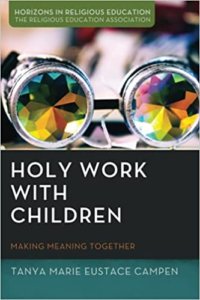Tanya Campen describes how engaging children through active wondering creates space for them to share freely and nurtures honest conversation. She equips teachers and guides to shepherd children in the holy work of active wondering.
Active wondering creates space for authentic and honest conversation. “I wonder” questions present an invitation into holy conversation. They create a space for children to share freely, to address issues of power and authority, and to nurture honest and raw conversation and feedback. Using this method in a safe space built on trust and respect frees children to contribute their thoughts willingly, decreasing the risk of providing an expected answer or parroting another adult figure in their community. Active wondering nurtures and fuels a continued dialogue, encouraging participants to share their own reflections and insights. This creates space for all of the theologians in the room to join in the divine dance as they discern what God is saying to them in that moment, and as they share that insight with the entire group.
Ask wondering questions.
Wondering with children can have significant impact in ministry settings. Through modeling, the teacher encourages this process, giving permission for all present to wonder out loud, inviting both the children and the adults to participate in the conversation by sharing new insight and discoveries. Some examples of wondering questions from Godly Play and my research liturgy include:
- I wonder how you felt God’s presence this week?
- I wonder what is your favorite part of the story?
- I wonder how you discovered yourself in this story?
- I wonder how you experienced God in this story?
- I wonder if there’s any part of the story we can leave out and still have all the story we need?
- I wonder what you wonder about?
Be a shepherd.
Teachers do this work as shepherds. Shepherds guide the conversation and model helpful language as the community explores its religious language and understanding. We create space to do this work and then, as shepherds, we ask the big questions and invite participants to respond. We might participate in the conversation, too. However it is essential that as the shepherd and guide we avoid being the first and the last person to share. Instead, we can open the conversation with a wondering question: “I wonder how you experienced God this week?” Then we can insert our wonderings after some of the children have had a chance to respond, followed by an invitation for the children to join in again too. It is important that we facilitate mutual conversation that is not overwhelmed by the voices of adults. When the time comes to close the conversation, simply conclude with an affirming statement, “Thank you for wondering with me today,” rather than ending with one final contribution. Refraining from oversharing or learning to sit in silence are often the hardest parts of this pedagogical approach.
Be comfortable with silence.
As shepherds and guides, our task is to learn how to be comfortable with silence as we wait for a participant to share. When I begin this work with a new group, I find it often takes a couple of sessions for participants to trust that the space is safe enough to wonder out loud (rather than be clever or give the “right” answer). Building a safe space where participants feel brave enough to share takes time and intentional work.
Create an environment that values sharing.
Nurturing this space and creating an environment where children want to share requires a deep sense of trust of all participants in the leadership, the members of the community, and the process. Leaders must model and maintain a safe space where all wonderings are heard and considered. While some responses might be particularly humorous or fitting, it is important that children and adults alike honor every answer that is presented and that they not respond simply with an affirmation to the wondering, such as “I really like that answer” but instead use every response as an opportunity to further the conversation. For example: “Hmmm, thank you for sharing. I wonder what others think?”
Invite children to share.
It is through active wondering, beginning each question with “I wonder,” that we teachers and guides invite and encourage children to share their stories, reminding them that their thoughts matter, that they have something to teach us and the rest of the community. As one eight-year-old boy stated in one of my research sessions, “Wonder is a good word.” Wonder is indeed a good word and an important tool for ministry with children. Wonder is an active word that invites us to participate without judgment, to create without seeking perfection, and to try without the fear of being corrected or being presented with the “correct answer.” Our role as adults in ministry with children is not to provide children with information or the correct answer.
We can encourage children in the work of reflection, wondering, and discovery by inviting them into the mystery and into the realm of possibilities.
Four possible responses to active wondering
Active wondering can be an invitation to conversation and discovery. This takes practice. Recall, first, that our work is not to provide answers but to hold the space open, to invite wonder and awe, and to encourage possibilities and discovery. Recall, second, that we must choose our responses carefully. Our options during an active wondering session are to respond with:
- Silence: Silence creates space for all participants to take in what has been said and added to the conversation. Often another participant will respond when we give silent time and space for contemplation.
- Encouragement: We encourage what is said by noting “Thank you for sharing” or “I wonder about that too.”
- Clarification: We can use the opportunity to clarify what we hear the participant saying by repeating what the child said (“Hmmm, God is with us when we are scared.”) or by saying, “That’s interesting. Can you tell me more about that?”
- Another wondering question: Follow up with another wondering question like, “Thank you for all your thoughts. I wonder what God is calling us to do next?
When we work to create safe space and encourage others to wonder what God is saying to them that day, participants of all ages respond. When we invite and encourage them to wonder, children willingly respond to the questions and begin asking questions of their own.When we join with the children in this wondering process, we open our hearts and minds to all the possibilities God presents. We offer an invitation for people of all ages to participate in God’s dance as we listen for God and discern what God is saying to us and our community on that day.
It is through this process that we model and practice theological reflection, sharing our insight with others. This tool creates space for us to do holy work together.
 This article is adapted from Holy Work with Children: Making Meaning Together (Pickwick Publications, 2021) by Tanya Campen. Used with permission from Wipf and Stock Publishers, www.wipfandstock.com. This book is available at Wipf and Stock, Cokesbury, and Amazon.
This article is adapted from Holy Work with Children: Making Meaning Together (Pickwick Publications, 2021) by Tanya Campen. Used with permission from Wipf and Stock Publishers, www.wipfandstock.com. This book is available at Wipf and Stock, Cokesbury, and Amazon.
Related Resources
- The Holy Work of Hybrid and Virtual Christian Education featuring Tanya Campen — Leading Ideas Talks podcast episode | Podcast video | In-depth interview
- Are You Teaching People about Faith? Or How to Practice It? by Johannah Myers
- 50 Ways to Strengthen Ministry With Children, a free Lewis Center resource
If you would like to share this article in your newsletter or other publication, please review our reprint guidelines.






